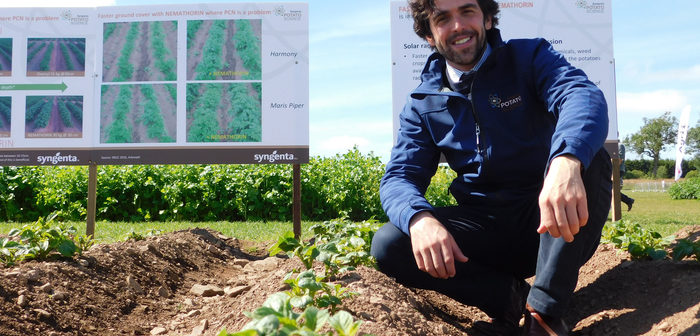Potato Cyst Nematode feeding activity on potato crop roots can severely delay emergence and, in pest hot-spots, result in patchy crops that never catch up, warns Syngenta technical manager, Douglas Dyas.
Demonstrating the effects of delayed emergence at Potatoes in Practice near Dundee this week (10 August 2017), Douglas highlighted that even a few days of difference in emergence can have a lasting legacy on potato crop productivity.
Rapid emergence assures the longest possible growing season to achieve high yields, whilst even emergence is important for consistent tuber size and maturity at harvest, he told visitors to PiP.
“Stronger root systems of crops protected from PCN damage by Nemathorin nematicide treatment would also be more efficient at scavenging for soil moisture and fully utilising fertiliser nutrients,” suggested Douglas.
“Rapid ground cover from a fast growing crop can be extremely effective in suppressing weeds and ensure the best possible results from pre-emergence herbicide applications.”
Douglas pointed out that growers need to understand the differences between resistant and tolerant potato varieties – and their relative susceptibility to different PCN species.
“Tolerant varieties typically appear to be better able to withstand the effects of PCN in the field, but can still see large cyst populations multiply by the end of the season – that will affect future crops in the rotation,” he warned. “Resistant varieties have been shown to reduce the build-up of PCN populations, but crops will be adversely affected during the growing season and require nematicide treatment to protect yield.”
Furthermore, Douglas reminded growers that tolerant and resistant varieties can potentially respond differently to the key PCN species, Globodera pallida and G. rostochiensis. “The later hatching and more difficult to control G. pallida has tended to become a far greater problem in recent years – which has been largely attributed to the widespread growing of Maris Piper that allowed the species to proliferate.
“However, whilst soil sampling results has shown most PCN populations are predominantly G. pallida, growing a variety exclusively resistant and/or tolerant to G. pallida could still see G. rostochiensis resurface as a serious issue.”
Douglas advocated that variety selection is an important part of an Integrated Pest Management of PCN and can be extremely useful in utilising some fields where pest levels would otherwise preclude economic growing. “But in all instances, where the pest is a known problem, they should be grown in combination with Nemathorin for an effective long-term strategy,” he advised.
“Key to that is soil testing to know the scale of PCN threat before the crop goes into the ground, ideally along with speciation of the soil sample to understand the target and best approach for control,” he added. Douglas used the PiP demonstration to discuss techniques and options to develop an effective IPM approach to PCN management.




